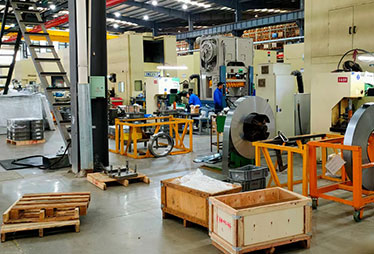Call Us
+86 13456143169
Email Us
76405779@qq.com
How to debug and reduce noise of high speed punch
2022-07-18
The collision between the CNC blade and the product workpiece or the reversing plate and the embryo material is the cause of the high speed punching machine's load running noise. Torsion and longitudinal shear in the whole process of stamping die design. Among them, the torsional and longitudinal shear noise in the whole process of stamping die is more prominent. The following is the actual display:
1. Longitudinal shear noise. The design process of stamping dies is different, and the noise varies greatly. The cold stamping noise of the sheet is greater than that of bending and deep drawing, while the forming process noise of printing, pressing, reverse side, bending and deep drawing is less.
2. Torsional noise. Similar to the torsional noise of a high speed punch, it is related to the thickness, strength, geometric appearance of the stamping die member, blow rate, stamping die clearance and other factors, and the noise increases with the expansion of this value. During the working process of the high-speed punching machine, the impact impact of the needle, the plate, the feeding plate and the embryo is greatly improved. With the increase of the impact rate, the percussion sound also increases. The raw material cracking sound generated between the impact noise can be measured by itself, and this measurement method has been widely promoted. On the same high-speed punch, cold stamping is thick. Hard materials are thinner than cold stamping. Soft materials are very noisy. For thick plastic panels, the crash noise is the same as the cracking noise.
1. Longitudinal shear noise. The design process of stamping dies is different, and the noise varies greatly. The cold stamping noise of the sheet is greater than that of bending and deep drawing, while the forming process noise of printing, pressing, reverse side, bending and deep drawing is less.
2. Torsional noise. Similar to the torsional noise of a high speed punch, it is related to the thickness, strength, geometric appearance of the stamping die member, blow rate, stamping die clearance and other factors, and the noise increases with the expansion of this value. During the working process of the high-speed punching machine, the impact impact of the needle, the plate, the feeding plate and the embryo is greatly improved. With the increase of the impact rate, the percussion sound also increases. The raw material cracking sound generated between the impact noise can be measured by itself, and this measurement method has been widely promoted. On the same high-speed punch, cold stamping is thick. Hard materials are thinner than cold stamping. Soft materials are very noisy. For thick plastic panels, the crash noise is the same as the cracking noise.
When the noise of the high-speed punching machine is serious, it will cause adverse harm to the actual operators of the production workshop and the surrounding environment, so effective sound insulation and noise reduction measures should be taken.























































